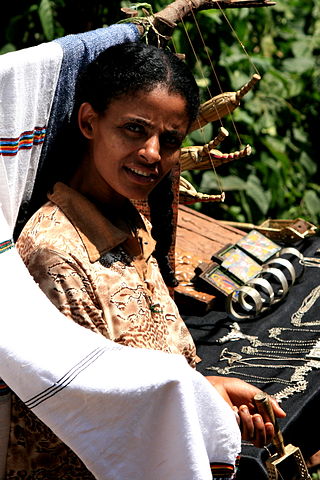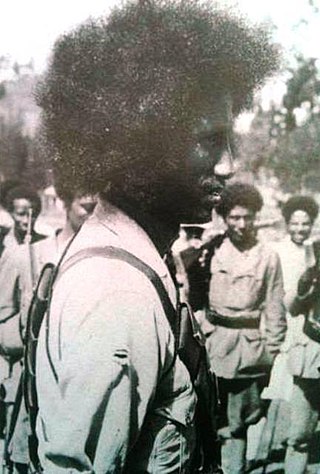Related Research Articles

Amharas are a Semitic-speaking ethnic group indigenous to Ethiopia, traditionally inhabiting parts of the northwest Highlands of Ethiopia, particularly inhabiting the Amhara Region. According to the 2007 national census, Amharas numbered 19,867,817 individuals, comprising 26.9% of Ethiopia's population, and they are mostly Oriental Orthodox Christian.

The Solomonic dynasty, also known as the House of Solomon, was the ruling dynasty of the Ethiopian Empire from the thirteenth to twentieth centuries. The dynasty was founded by Yekuno Amlak, who overthrew the Zagwe dynasty in 1270. His successors claimed he was descended from the legendary king Menelik I, the supposed son of the biblical King Solomon and the Queen of Sheba, in order to legitimize the dynasty's assumption of power. Although this claimed ancestry gave the dynasty its name, there is no credible evidence that the dynasty was descended from Solomon or the Davidic line. The Solomonic dynasty remained in power until 1974, when its last emperor Haile Selassie was overthrown by a coup d'état.

Yohannes I, also known as Yohannes the Righteous, throne name A'ilaf Sagad was Emperor of Ethiopia from 1667 to 1682, and a member of the Solomonic dynasty. He was the fourth son of Fasilides.

Iyasu I, throne name Adyam Sagad, also known as Iyasu the Great, was Emperor of Ethiopia from 19 July 1682 until his death in 1706, and a member of the Solomonic dynasty.
Tekle Haymanot I, throne name Le`al Sagad was Emperor of Ethiopia from 27 March 1706 until his death in 1708, and a member of the Solomonic dynasty. He was the son of Iyasu I and Empress Malakotawit. He is often referred to as "Irgum Tekle Haymanot" or "Tekle Haymanot the Cursed".
Nagasi Krestos was the ruling prince of Shewa, an important Amhara noble of Ethiopia. Nagasi succeeded to unite fragmented Amhara districts in Shewa, and launched several wars of reconquest of Shewan territories against his Oromo enemies.

Darge Sahle Selassie, also known by his horse name Abba Gersa, was a 19th-century Ethiopian nobleman, provincial governor, general, and a trusted councillor to his nephew, Emperor Menelik II.
Dera is one of the woredas in the Amhara Region of Ethiopia. Part of the Debub Gondar Zone, Dera is bordered on the south and west by the Bahir Dar, Zenzelma subcity located in Semien Gojjam zone, on the west by Lake Tana, on the north by Fogera, on the northeast by Misraq Este, and on the east by Mirab Este. The main settlement in Dera is Wereta, other towns in Dera include Amba Same, Arb Gebeya and Hamusit.

Semien Province was a historical province of northwest Ethiopia. According to Manoel De Almeida Semien was bordered on the north-east and north by Tigray and Tselemt, on the east and south by Abergele, and on the west by Wegera. Alexander Murray include Wag as part of Semien.

Belay Zeleke was an Ethiopian military commander who led the Arbegnoch resistance movement in Gojjam against the Fascist Italians during the Italian occupation of Ethiopia from 1936 to 1941. He emerged as a brigand leader after his five-year struggle against Italian rule in Ethiopia.
Leul Sagad Atnaf Sagad, also known by his horse name Abba Balay, was an Ethiopian courtier and army commander (Ras) under Emperor Menelik II. A key figure in late 19th and early 20th century, he was responsible for several successful military campaigns, but was killed in battle during the struggle over Menelik's succession.
Bafena Wolde Mikael or better known as just Bafena (1834-1887) was the second wife of Menelik II then the King of Shewa. She was described as ‘‘attractive, vivacious and ambitious’’ and is remembered for her failed conspiracy against her husband, in a attempted coup plot in 1877.
Bashah Aboye horse name: Abba Däffar, was a distinguished Ethiopian military commander under Emperor Menelik II, and governor of several former principalities and regions in the south. Bashah died fighting the Italians during the Battle of Adwa.
Garmame and Horse name: Abba Mala was an influential 19th century Ethiopian military commander, provincial governor and royal counsellor serving under Negus Sahle Selassie, Haile Melekot and Emperor Menelik II. He held the title of Dejazmach. Garmame is remembered for his leading role in rescuing Menelik II and other notables from captivity in July 1865, and restoring the Shewan heir back to the throne. In May 1877 he prevented a coup concocted by Bafena, and solidified the position of his Negus. After retirement from military activities, Garmame governed large tracts of fertile land south of Ankober, and is also remembered for his role in providing relief to the people during the disastrous 1890's famine'.
Betul Haile Maryam was a member of the Semien nobility through his paternal line in the Ethiopian Empire.
Fesseha Krestos was an Ethiopian commander of the royal guard regiment under Iyasu I, he was one of the closest confidants of the Emperor.
Anestasyos, was one of the most prominent figures of 17th-century Ethiopia. He held several positions during the reigns of Fasilides, Yohannes I and Iyasu I. The latter relied on Anestasyos military prowess and made him Ras Bitwoded. Over the course of his career he became the provincial governor of Amhara, Damot, Semien and Shewa.
Hawarya Krestos was a member of the Gondarine court and royal chronicler.
Akala Krestos was a high court administrator during the reigns of Yohannes I and Iyasu I.
Walda Giyorgis was an ecclesiastic during the reign of Menelik II.
References
- 1 2 Budge, Ernest Alfred Thompson Wallis (1966). A history of Ethiopia, Nubia & Abyssinia. According to the hieroglyphic inscriptions of Egypt and Nubia, and the Ethiopian chronicles . London, Oosterhout: Methuen (1928), N.B. Anthropological Publications (1966). p. 409. OCLC 874381390.
- 1 2 3 4 Uhlig, Siegbert; Bausi, Alessandro; Yimam, Baye, eds. (2003). Encyclopaedia Aethiopica: D-Ha. Wiesbaden: Harrassowitz. p. 129. ISBN 9783447052382.
{{cite book}}:|work=ignored (help) - 1 2 3 Alāf Sagad, Zenahu la negus negast (1955). Annales Iohannis I, Iyāsu I, Bakāffā. Louvain L. Durbecq. p. 44. OCLC 1244212657.
Le 7° jour depuis que le brouillard était Lombé, le roi ayant envoyé le daÿäzmaäè Demyanos, alla vers Dabot, en détruisit la forteresse et en pilla tous les objets (les richesses). Car les Paysan: ne pouvaient pas lui opposer résistance, pas plus que le roseau au feu brûlant. Le 8° jour après les ténèbres du brouillard, lorsque le soleil resplendit de nouveau comme d'ordinaire et que le brouillard fut dispersé, tous les chefs sortirent du camp, prêts à faire la guerre sur l'ordre du Roi des rois A'läf Sagad. Le daigaz mas Demya- hos et le Zan serär Hawaryä s'étant réunis tous les deux, en se séparant des chefs, mirent en fuite les Paysans et leur firent aban- donner les maisons bâties sur le versant du mont, dont le nom est Maskot, que les chefs antérieurs et les rois devenus fameux n'avaient pas réussi à gagner. Après avoir dispersé les Paysans, comme la : fumée ou les cendres d'une fournaise, ils brûlèrent les maisons de ce pays de Maskot, dont la route est étroite et resserrée. Qüelques- uns des combattants trouvèrent des tentes, d'autres apportèrent des trompettes; les autres richesses trouvées étaient innombrables. Alors la majesté du Roi des rois A'Iaf Sagad épouvanta tous les habi- tants du Laslä, comme un lion terrible ou une ourse qui a mis bas.
[On the 7th day since the fog was Lombé, the king having sent the daÿäzmaäè Demyanos, went towards Dabot, destroyed the fortress and plundered all the objects (wealth). For the Peasants: could not oppose him any more resistance than the reed to the burning fire. On the 8th day after the darkness of the fog, when the sun shone again as usual and the fog was dispersed, all the leaders came out of the camp, ready to make war on the order of the King of kings A'läf Sagad. The daigaz mas Demyahos and the Zan serär Hawaryä having both united, separating from the chiefs, put the Peasants to flight and made them abandon the houses built on the slope of the mountain, whose name is Maskot. , which earlier chiefs and kings who became famous had failed to win. After having dispersed the Peasants, like the smoke or the ashes of a furnace, they burned the houses of this country of Maskot, whose road is narrow and constricted. Some of the combatants found tents, others brought trumpets; the other riches found were innumerable. Then the majesty of the King of kings A'Iaf Sagad terrified all the inhabitants of Laslä, like a terrible lion or a bear that has given birth.] - ↑ Uhlig, Siegbert; Bausi, Alessandro, eds. (2003). Encyclopaedia Aethiopica: He-N. Wiesbaden. p. 783. ISBN 9783447056076. OCLC 921905105.
{{cite book}}:|work=ignored (help)CS1 maint: location missing publisher (link) - ↑ Uhlig, Siegbert; Bausi, Alessandro; Yimam, Baye (2010). Encyclopaedia Aethiopica: O-X. Wiesbaden: Harrassowitz Verlag. pp. 459–460. ISBN 978-3-447-06246-6.
{{cite book}}:|work=ignored (help)